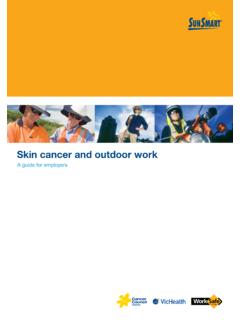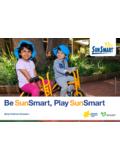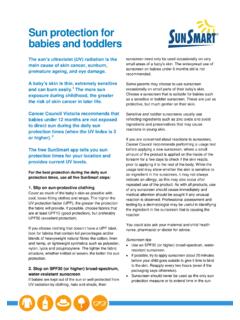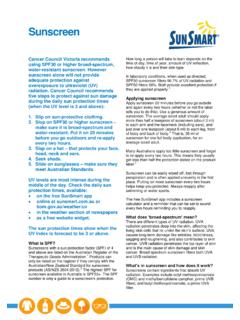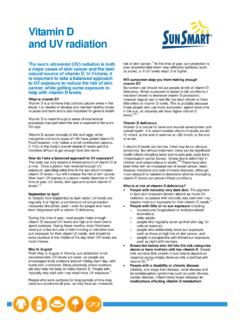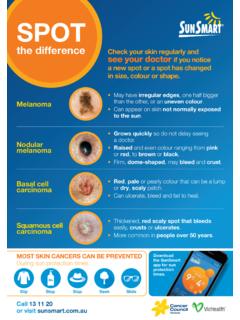Transcription of twenty years onSUNSMART - Skin cancer
1 SUNSMART twenty years onWhat can we learn from this successful health promotion campaign?a summarycommunitysponsorshipschoolsoutdoo r workersrecreationleisuretelevisioneducat ionmeg montague PhD, ron borland PhD, craig sinclairSunSmart twenty years On is an edited extract from a fully referenced publishedpaper by Montague M, Borland R and Sinclair C. Slip! Slop! Slap! and SunSmart1980 to 2000: Skin cancer Control and 20 years of Population Based Education and BehaviourVolume 28, Number 3, June edited version prepared by Redman K, Sinclair C and Stent S. June Anti- cancer Council of Victoria has been running a sunprotection program for over 20 years Slip! Slop! Slap! from1980 to 1988 and the SunSmart Program from 1988 to thepresent. The sun protection program has played an importantrole in changing society s attitudes and has helped to achievemarked reductions in sun exposure.
2 The Victorian HealthPromotion Foundation has provided funding for the SunSmartProgram since its inception. What has made this health promotion program so successful,and what can we learn from it to help with the planning offuture campaigns? In an attempt to answer these questions,this paper provides a background on the program relating toits social, political, economic and organisational context andidentifies eleven critical aspects of its development andimplementation. The authors conclude that the success of thesun protection program has been built on two key elements the integration of research and evaluation on the one hand,and a basis of consistency and continuity on the other providing a solid foundation for dealing with future MONOGRAPH 7/20/01 4:04 PM Page 12 BackgroundAustralia has the highest incidence of skin cancer of any countr y in theworld.
3 One out of two Australians will be treated for skin cancer during their lifetime. Melanoma is now the third most common cancer , and of allforms of cancer it results in the highest costs to the nation s health latest estimates are that costs are over $232 million per year for non-melanoma and over $65 million for melanoma skin the Anti- cancer Council of Victoria launched the Slip! Slop! Slap!Campaign in 1980, a number of initiatives have been taken to encourageAustralians to reduce their exposure to the sun. These include an annualNational Skin cancer Awareness Week, the establishment of centres for behavioural research and epidemiological research, the establishment of theVictorian Health Promotion Foundation (VicHealth) and the launching in 1988 of the SunSmart Program. SunSmart incorporates mass media work, sponsorship of sporting organisations, resource development and dissemination, professional education, advocacy of policy development and a strong research and evaluation component.
4 The overall aim of the SunSmart Program is to changepersonal and institutionalattitudes and behaviours, through environmental and organisational change and control of existing disease, and to reduce the incidence and mortality of skin program and sponsorship funding for SunSmart is around half a million dollars per annum, while the Anti- cancer Council has maintainedan annual commitment of around a quarter of a million dollars in funds and in has been achieved?After 13 years , SunSmart s research and evaluation work provides extensive evidence of changes in attitudes, knowledge, behaviour, policies, regulations, practices and legislation. Attitude changeSur vey research shows that over the period since SunSmartwas launchedthe propor tion of Victorians who like to get a suntan has decreased markedly,from 61 per cent in 1988 to 35 per cent in 1998.
5 The percentage agreeingthat friends think a suntan is a good idea dropped from 69 per cent in1988 to 36 per cent in 1998, those agreeing that it is easier to enjoy summer once you get a tan fell from 62 per cent to 29 per cent over theperiod, and those agreeing that I feel more healthy with a suntan fell from51 per cent to 20 per cent. Behaviour changeFindings from a SunSmart sur vey show a consistent increase over the last13 years in the proportion of people who report seeking shade, using a hatand sunscreen, covering up and choosing not to go out in the sun between11 am and 3 pm on summer weekends. There has been a 50 per centreduction in people getting sunburnt in the decade from :UVR,temperature,month,sex,age,skin typeBaseline yearSunSmart in summer weekend sunburn VictoriaAW515 MONOGRAPH 7/20/01 4:04 PM Page 23 Structural and organisational changeStructural or institutional change related to the SunSmart Program hasoccurred in a range of organisational settings.
6 For example, SunSmartworked with trade unions representing outdoor workers, to develop occupational health and safety guidelines for sun protection. These are nowthe basis of industrial awards and are standard practice throughout SunSmart accreditation program has operated in Victorian primar y schoolssince 1994. By December 2000, 71 per cent of all primar y schools wereaccredited as SunSmart Schools. Accredited schools adopt a sun protectionpolicy, that includes compulsor y hat wearing for children playing outside inthe two summer terms, considers structural approaches to enhance sun protection such as shade and includes sun protection in the curriculum. Theprogram has now been adopted throughout most of 1998, over a third of Local Government Authorities (LGAs) reported having sun protection policies in their Municipal Health Plan. Fifty-two percent had a sun protection policy for outdoor staff, compared to the 29 percent of LGAs that had such a policy in 1990.
7 Thirty-seven per cent of LGAswith outdoor swimming pools had shade over all wading pools, compared toonly 20 per cent in 1993, and 72 per cent of LGAs had a policy or set of procedures that dealt specifically with sun protection compared with only 22 per cent in 1990. A significant proportion of sport and leisure organisations, workplaces and community health centres have also adopted sun protection policies,regulations and practices. Weather forecasting, the fashion industr y, solariums, building design, industrial awards, occupational health and safetypractices, sunscreen production and pricing, hat, swimwear and shade manufacture have all been influenced by the program. At the beach, hats and protective swimwear are the norm for children andare frequently worn by adults. Personal shade structures are commonplace,and lifesavers demonstrate and promote SunSmart behaviour.
8 Sun protection is now an integral part of Victorian life. The word sunsmart has become absorbed into the language to describe sensible behaviour inrelation to the in skin cancer incidence and mortality ratesEvidence is emerging that skin cancer incidence rates are beginning toplateau after decades of increase. Rates of skin cancer in young people arefalling and earlier detection of skin cancer is leading to better treatment andlong-term outcomes throughout the whole population. The general picture is one of success for the SunSmart Program. Whatwas the context within which it developed, and what critical insights canbe drawn from our experience of over 20 years ?0510152025303540198219841986198 819901992199419961998 year of diagnosis /deathMALEFEMALEMALEFEMALEINCIDENCEMORTA LITYT rends in melanoma incidence & mortalityAustralia 1982 1998AW515 MONOGRAPH 7/20/01 4:04 PM Page 34 Factors contributing toSunSmart s success Positive factors relating to the specific health issue Health promotion is not always easy, but as an issue, skin cancer preventionhas a number of things going for it.
9 Most people know someone who hashad skin cancer . Skin cancer does not discriminate between class, genderor to a more limited extent, skin type. It is preventable, however there aresome simple and effective steps people can take. It is detectable largelywithout invasive procedures, and individuals as well as medical professionalscan be alerted to the indications of skin cancer . It can be treated successfullyin 95 per cent of cases if detected contrast to some other health-related campaigns, for example anti-smokingprograms, there are no obvious moral or commercial opponents of protectivemessages in fact many commercial opportunities have sprung up as aresult of the increasing demand for protective products and ser vices. Skin cancer prevention messages are generally not perceived as threateningby governments or political par ties, since they involve little or no erosion of taxrevenue, nor are they likely to diminish voter suppor t or financial terms of reaching and covering the general population, many of the harderto reach groups, such as newly arrived migrants, are at lower risk, so it isnot difficult to ensure equity across the social, political and economic environment Social, economic and political environment factors have been important bothfor the development, funding and directions of the sun protection programand in terms of community receptivity to campaign messages.
10 Central to its success has been the capacity to be seen on the agenda of the wholecommunity, helping to stimulate change in social the eighties, while the Australian program was being developed, there was an international emphasis on healthy communities and on preventiveapproaches par t of a new public health agenda. This was reflected by thefirst International Conference on Health Promotion, held in Ottawa in 1986;the publication of the Ottawa Charter for Health Promotion;and thedevelopment of the World Health Organization s Healthy Cities Program. Inmany respects, the Anti- cancer Council s education and health programsbuilt on these foundations and the principles they and internationally in the late eighties there was also growing community concern over a range of environmental issues, including damage to the ozone layer and the consequent increased risk from ultraviolet may have helped to speed up program development and public acceptance of skin cancer prevention messages.
